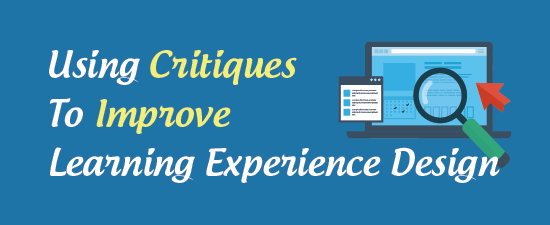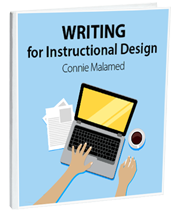
Critiques for learning experience design are beginning to catch on. The input from others can bring new perspectives and insight to a draft or beta version of any work. Critiques are a collaborative effort to help designers formulate or refine their ideas. Critiques involve calling together a group of people to assess an approach while it is still a sketch, wireframe or prototype. It is not an opportunity to vent or criticize.
Because it’s difficult to work in a vacuum, you might like to know how to run a design critique. If you’d like to start using design critiques or you want to improve the current approach you and your colleagues are taking, then go through these curated resources. They are arranged into seven lessons explaining how you can start doing critiques for learning experience design. Read the lessons and check the resources below.
Seven Lessons
Lesson 1: How to Improve Your Skills and Products with Design Critiques
In this podcast, I interview Adam Connor, co-author of Discussing Design. He offers valuable guidance on what a critique should accomplish. Apply his tips for how to use critiques for learning experience design at your organization.
Lesson 2: Design Critiques: Encourage a Positive Culture to Improve Products by Sarah Gibbons
Gibbons, UX specialist with Neilson Norman Group, provides a good primer on design critiques. She explains what critiques are, their value, how to facilitate a critique. You’ll also learn how to present your design during a critique. Read this to see how critiques benefit designers and their organizations.
Lesson 3: How to Run a Design Critique by Scott Berkun
This comprehensive and lengthy article explains the critique process. You’ll learn how to lead the way, who should participate and the types of questions to ask. Most important, you’ll see how to keep critiques from getting personal. This lesson will give you what you need to get started with design critiques.
Lesson 4: Four Things Working at Facebook has Taught Me About Design CrItiques by Tanner Christensen
This is one more article that provides a good foundation for running a design critique. Of particular interest, is the difference between criticism and critique. This point can’t be stressed enough.
Lesson 5: 20 Ways to Make Your Design Critiques More Effective by Neil Turner
Once you get the basics covered, you may wish to improve the the process. This article offers many ways to improve the culture surrounding critiques in the workplace. You’ll find lots of good ideas for making things go smoothly.
Lesson 6: Design Criticism and the Creative Process by Cassie McDaniel
The theme of this article is to adopt a collaborative attitude for an effective critiques. With this in mind, McDaniel provides numerous ways to clarify vague feedback in order to improve your design.
Lesson 7: Google Ventures Guide to Design Critiques by Braden Kowitz
If you’re using critiques for learning experience design, you don’t want to leave the meeting feeling scattered. In this article, you’ll learn how to set the stage and how to simulate the flow of the experience. In our case, showing the flow of the learner’s experience is an excellent way to examine and assess a design.
Design Critique Resources
Running Asynchronous Design Critiques
Design critiques are typically organized for a synchronous meeting, where you can explain your goals and get immediate reactions to your approach. In these two articles below, Erin Casali explains how to do this in an asynchronous environment. The articles below have good advice no matter how you’re running things.
- Asynchronous Design Critiques: Giving Feedback-Part 1 by Erin Casali
- Asynchronous Design Critiques: Getting Feedback-Part 2 by Erin Casali
Books
- Discussing Design: Improving Communication and Collaboration through Critique by Adam Connor and Aaron Irizarry. A practical guide teaching collaborative teams how to give and receive critiques.
- Articulating Design Decisions by
- Art Critiques, A Guide by James Elkins. Although this book is only partially relevant, it discusses art critiques as part of studio art classes. Yet, you can get a sense of how and why critiques started. There is some valuable information that applies to any type of critique.
Checklists



I believe that Critiques on your work can be very beneficial to both the designer being critiqued and the person doing the critiquing. For the designer, they can see their product through someone else’s eyes. This can be a very powerful tool because it allows the designer to take a step back from your own creation. The critique allows someone else to maybe catch something that doesn’t make sense or perhaps suggest a better way of completing a certain task. When receiving a critique, you must remove your ego from the equation this will allow you to not take the critique as a judgment on you.
For the critique, they get to see how some else completes certain tasks. This might help them in their own design process. I have Critiques co-workers project and almost every time have been amazed by something they did. I then take that and incorporate it into my own design process.
Critiques are a very powerful tool, which if done correctly can help enhance the product a designer is working on.